

Challenge. View the movie below and then proceed to the Initial Thoughts section (time: 1:49).
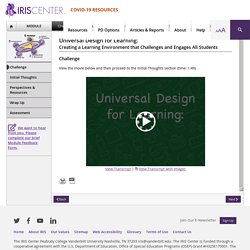
Transcript: Challenge Sycamore Middle School is an urban school with a large percentage of students from diverse backgrounds. Eleven percent of its students have disabilities, a typical number for the district, 85 percent receive free or reduced lunches. Although some of the school’s students perform well academically, a number of them do not score in the proficient range on the required subject areas on the end-of-year standardized test. : About CAST. Moving Online Learning from Challenge to Opportunity.
Online Learning Moving Online Learning from Challenge to Opportunity The future of higher education means breaking down classroom walls, embracing digital tools and engaging students with creativity and innovation.

By Dr. Mark Lombardi03/17/21. Web Accessibility Initiative (WAI) ADA Compliance for Online Course Design. Key Takeaways Lessons learned from campuses nationwide have informed an approach to compliance with the Americans with Disabilities Act during the process of online course design.Providing multiple ways for students to gain knowledge, demonstrate knowledge, and interact goes a long way toward making a course accessible to all students, including those with disabilities.Accessibility efforts benefit not only students with disabilities but also students who are English language learners and those working in noisy or quiet environments.
A Growing Community. Modernize Your Campus Network for Blended Learning. Higher education is poised to disrupt and transform the educational experience by leveraging blended learning to drive student outcomes, equity, and accessibility.
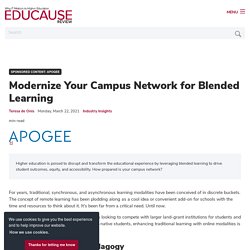
How prepared is your campus network? For years, traditional, synchronous, and asynchronous learning modalities have been conceived of in discrete buckets. The concept of remote learning has been plodding along as a cool idea or convenient add-on for schools with the time and resources to think about it. It's been far from a critical need. Until now. Online Learning. The Power of Asynchronous Video. A set of seven articles discusses the benefits of asynchronous video and provides specific guidance about how to effectively incorporate these tools to improve learning.

Prior to the pandemic, instructors taught courses either fully or partially online, using a wide range of tools to teach and connect with students. When the pandemic abruptly curtailed most in-person learning, the number of courses being taught online grew exponentially. Many instructors turned to videoconferencing tools to facilitate their teaching, perhaps because they offer the most obvious approximation of an in-class experience. Videoconferencing tools allowed instructors and students to engage in real-time interactions while maintaining the same class schedule as before the pandemic. Features such as polling and breakout rooms allowed students to engage in interactive and collaborative activities similar to what they would have done in person.
10 Tips for Effective Online Discussions. These tips can help educators ensure that online discussions are engaging and beneficial for postsecondary students. For many of today's students and more than a few educators, effective participation in online discussions in postsecondary education may not be second nature. In particular, graduate-level discussions present challenges quite different from their undergraduate counterparts, as master's degree candidates tend to be highly motivated.
This may mean that they frequently exceed the minimum number of required posts and write longer entries. The recommendations below are based on my own experience teaching fully online graduate courses with fifteen to twenty students, although many of these points would benefit those teaching at the undergraduate level as well. 1. COVID-19 Planning for Fall 2020: A Closer Look at Hybrid-Flexible Course Design - PhilOnEdTech. Since I have only written guest blog posts, many of you won’t know of my plans to write a modern-day, Gulliver’s Travels-esque satire.

The hero or anti-hero – I haven’t yet decided which – travels time instead of oceans. Namely, he can jump to different possible futures and see the repercussions of present day decisions. How many of us would like that ability right now, as we make decisions about fall 2020? I bring this up because I recently included a brief paragraph about how we should “consider ‘hybrid flexible’ course design to support ‘remote flexible’ courses” in the fall. I then followed up on this idea in “Considering Hybrid (Flexible) Models,” a podcast episode conversation with colleagues Phil Hill and Jeanette Wiseman. The World (Re)Discovered HyFlex. Hybrid, HyFlex, Online, and Everything in Between: Course Models at a Glance. As higher education’s instructors and administrators plan for fall 2020, there has been a lot of discussion about what different course models might look like given the interactions that might span places, spaces, and time zones.

Joshua Kim and Edward Maloney published a fantastic series on 15 possible scenarios for fall, while universities across the U.S. have been gradually rolling out announcements about whether or how they will bring undergraduate students back to in-person instruction in the fall. Where I currently work, at Stanford University, we recently learned that undergraduate students will be brought back to stay in residence halls in class-based cohorts.
Hybrid-Flexible Course Design. This volume provides readers with methods, case stories, and strategies related to Hybrid-Flexible (HyFlex) course design so that they may make decisions about using it themselves and even begin their own HyFlex course (re)design.
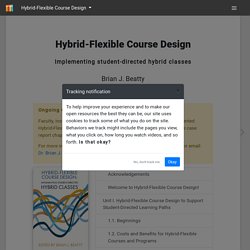
More specifically, based on the needs identified for their course(s), readers will be able to a) determine if and how HyFlex course design could help them solve critical needs, b) take advantage of emerging opportunities to improve their education practice, enabling them to better serve more students, c) gain an awareness of the HyFlex design, d) find their own innovative HyFlex solution to their specific challenges, and e) begin the HyFlex implementation process using strategies similar to those used by instructors described in this book. Beatty, B. J. (2019). Search for "blended learning" Just another WordPress site. Quality Assurance for Blended and Online Courses. The Quality Learning and Teaching (QLT; formerly QOLT) program was developed to assist faculty, faculty developers, and instructional designers to more effectively design and deliver online, blended, and flipped courses (e.g., Quality Assurance).

Moving Teaching Online. 8 Lessons Learned from Teaching Online. Storyline 2: Parts of the Body Drag and Drop. Discussion Rubric. University of Wisconsin - Stout — Schedule of Online Courses, Online Certificate Programs, and Graduate Degree Follow us on Facebook.
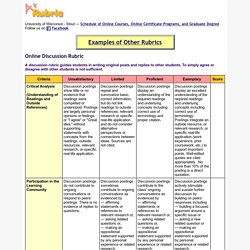
OSCQR Course Design Review. Free Online Course Materials. Generic Template Structure. Over the years, a number of institutions have identified features to be included in every online course.
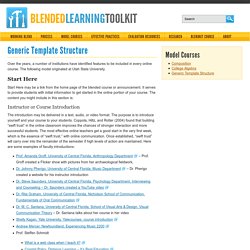
The following model originated at Utah State University. Start Here Start Here may be a link from the home page of the blended course or announcement. The Power of Asynchronous Video. Prepare for Classes & Boards. SAMR Model: A Practical Guide for EdTech Integration. The SAMR Model is a framework created by Dr. Ruben Puentedura that categorizes four different degrees of classroom technology integration. The letters "SAMR" stand for Substitution, Augmentation, Modification, and Redefinition. The SAMR model was created to share a common language across disciplines as teachers strive to help students visualize complex concepts. Image Modified from Original by Lefflerd’s on Wikimedia Commons While it’s often visualized as a ladder or staircase as above, this can be misleading because Substitution (the bottom of the ladder) is sometimes the best choice for a particular lesson.
Click here to learn how to transform static resources, particularly PDFs, into engaging content in 3 easy steps. Learning and Course Management Systems (LMS/CMS) Print Version by Richard Coble, PhD, CFT Graduate Teaching Fellow Systems such as Blackboard, Canvas, and Desire2Learn are becoming a vital part of university classrooms in the 21st Century. This guide seeks to bring clarity about the definitions, use, and possibilities of such systems for both instructors and students. After differentiating the definitions and scope of Learning and Course Management Systems (LMS/CMS), the guide explores how users on Vanderbilt’s campus were employing the current system during the 2015-2016 school year based on the results of a campus-wide survey held in the spring of that year.
Learn. Who's up and who's down in online enrollments? Home - Teaching Online Pedagogical Repository. OSCQR Annotations. OSCQR 3.0 Annotations 1. Course includes Welcome and Getting Started content. Review These Explanations: By welcoming learners to the course and providing context for what they will be learning, the instructor sets a tone for success from the start of the course. Learners benefit from an overview of the course, with general information about the nature and purpose of the course, the course activities, grading structure, and where to find the specific information on each.
Teaching Head & Neck Anatomy in a Blended Learning Environment - Teaching with Technology. By Robert W. Hasel, D.D.S., Associate Dean, College of Dental Medicine. How Western University of Health Sciences is using VR to teach. Western University of Health Sciences in Pomona, Calif., has opened a first-of-its-kind virtual reality learning center that’s been designed to allow students from every program — dentistry, osteopathic medicine, veterinary medicine, physical therapy, and nursing — to learn through VR. The Virtual Reality Learning Center currently houses four different VR technologies: the two zSpace displays, the Anatomage Virtual Dissection Table, the Oculus Rift, and Stanford anatomical models on iPad.
Robert W. Hasel, D.D.S., associate dean of simulation, immersion & digital learning at Western, says VR gives anatomical science teachers the ability to view and interact with anatomy in a way never before experienced. The virtual dissection table allows students to rotate the human body in 360 degrees, take it apart, identify specific structures, study individual systems, look at multiple views at the same time, take a trip inside the body, and look at holograms. Teaching Head & Neck Anatomy in a Blended Learning Environment - Teaching with Technology. Strengthen Your E-Learning Heart With These Medical Training Examples. Downloads. Getting Started with Articulate Storyline. Site - CourseNetworking. Softchalkcloud. Best Practices for Teaching Online. January 29 Designing Effective Team Projects in Online Courses By: Stephanie Smith Budhai PhD Participating in team projects offers students the chance to develop interpersonal communication skills (Figueira & Leal, 2013), build relationships with classmates, and increase the level of collective competencies as each group member brings something different to the group.
However, in the online environment where the majority of the work occurs asynchronously, students may resist having to work with others (Smith et al., 2011) on graded assignments. Blended and Flipped Learning Archives - Faculty Focus. June 15, 2015. Lecture Capture: A New Way to Think about Hybrid Courses - Faculty Focus. “Hybrid education” has become a hot catchphrase recently as faculty blend face-to-face learning with online technology. But the growth of hybrid education has been steered by the unstated assumption that hybrid technology should be used to facilitate discussion outside of the classroom, while classroom time should be spent lecturing. Using Blended Learning to Transform the Classroom Experience - Faculty Focus. When we maintain our focus on learning, the means used to help students learn dominates our thinking. Blended Learning Course Design Mistakes to Avoid.
Private Journal Replaces Discussion Forum in Blended Course. The discussion board in Kathleen Lowney’s large blended (or hybrid) section of introduction to sociology at Valdosta State University wasn’t serving its intended purpose of engaging learners with the content and preparing them for face-to-face class sessions. She tried dividing the students into smaller discussion groups of 50 and then 20, and the results were the same: the weaker students waited until the last minute and essentially repeated what the better students had posted previously. Designing Blended Courses the ADDIE Way. Blended Learning: Integrating Online and Face-to-Face Courses. December 12th, 2013. Can You Flip an Online Class? Formative Assessment: The Secret Sauce of Blended Success. Zencastr.